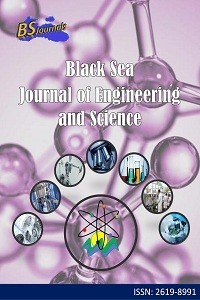Production of Reactive Alumina from Domestic Sources and Its Use in Alumina-Based Self-Flowing Castable Refractories
Seydişehir gibbsite, Reactive alumina, Self-flowing castable refractories, Fracture toughness
Production of Reactive Alumina from Domestic Sources and Its Use in Alumina-Based Self-Flowing Castable Refractories
Seydişehir gibbsite, Reactive alumina, Self-flowing castable refractories, Fracture toughness,
___
- Akselrod MS, Bruni FJ. 2012. Modern trends in crystal growth and new applications of sapphire. J Crystal Growth, 360: 134-145.
- Buhr A, Laurich J O. 2000. Synthetic alumina raw materials--key elements for innovative refractories. Metallurg Plant Technol Inter (Germany), 23(3): 62-64.
- Chang PL, Wu YC, Lai SJ, Yen FS. 2009. Size effects on χ-to α-Al2O3 phase transformation. J European Ceramic Soc, 29(16): 3341-3348.
- Fu X, Tang W, Ji L, Chen S. 2012. V2O5/Al2O3 composite photocatalyst: preparation, characterization, the role of Al2O3. Chem Engin J, 180:170-177.
- Gogtas C, Lopez HF, Sobolev K. 2014. Role of cement content on the properties of self-flowing Al2O3 refractory castables. J European Ceramic Soc, 34(5): 1365-1373.
- Göğtaş C, Ünlü N, Odabaşı A, Sezer L, Cınar F, Güner Ş, Göller G, Eruslu N. 2010. Preparation and characterisation of self-flowing refractory material containing 971U type microsilica. Advan Applied Ceramics, 109(1): 6-11.
- Gürel SB, Altun A. 2009. Reactive alumina production for the refractory industry. Powder Technol, 196(2): 115-121.
- Lee JS, Kim HS, Park NK, Lee TJ, Kang M. 2013. Low temperature synthesis of α-alumina from aluminum hydroxide hydrothermally synthesized using [Al(C2O4) x(OH) y] complexes. Chem Engin J, 230:351-360.
- Lee W, Vieira W, Zhang S, Ahari KG, Sarpoolaky H, Parr C. 2001. Castable refractory concretes. Inter Materials Rev, 46(3): 145-167.
- Luz A, Gabriel A, Consoni L, Aneziris C, Pandolfelli V. 2018. Self-reinforced high-alumina refractory castables. Ceramics Inter, 44(2): 2364-2375.
- Ma W, Brown PW. 1999. Mechanisms of reaction of hydratable aluminas. J American Ceramic Soc, 82(2): 453-456.
- Madono M. 1999. Alumina raw materials for the refractory industry. CN-Refractories, 6(3): 54-63.
- Otroj S, Sagaeian A, Daghighi A, Nemati ZA. 2010. The effect of nano-size additives on the electrical conductivity of matrix suspension and properties of self-flowing low-cement high alumina refractory castables. Ceramics Inter, 36(4): 1411-1416.
- Schnabel M, Buhr A, Kockegey-Lorenz R, Schmidtmeier D, Dutton J. 2014. Benefit of matrix alumina and modern dispersing systems in low cement castables. Interceram-Inter Ceramic Rev, 63:281-285.
- Silva AP, Segadães AM, Pinto DG, Oliveira LA, Devezas TC. 2012. Effect of particle size distribution and calcium aluminate cement on the rheological behaviour of all-alumina refractory castables. Powder Technol, 226:107-113.
- Xie ZP, Lu JW, Huang Y, Cheng YB. 2003. Influence of α-alumina seed on the morphology of grain growth in alumina ceramics from Bayer aluminum hydroxide. Materials Letters, 57(16-17): 2501-2508.
- Zhu L, Liu L, Sun C, Zhang X, Zhang L, Gao Z, Ye G, Li H. 2020. Low temperature synthesis of polyhedral α-Al2O3 nanoparticles through two different modes of planetary ball milling. Ceramics Inter, 46(18): 28414-28421.
- Yayın Aralığı: 6
- Başlangıç: 2018
- Yayıncı: Uğur ŞEN
Fındık Üretimi için Öğrenme Tabanlı Verim Tahmini
Doğan YILDIZ, Gülcan YILDIZ, Sercan DEMİRCİ
Ali Kaan YETİK, Tefide KIZILDENİZ, Zeynep ÜNAL
Hatice Şule ÇOBAN TETİK, Cemile Betül EMRULLAHOĞLU ABİ
A Hybrid Algorithm for Adaptive Neuro-controllers
Burak ÖZDEMİR, Erkan BAHÇE, Mehmet Sami GÜLER
Çinko-Triflat Katalizörü Kullanılarak Farklı Sübstitüe Izokumarin Türevlerinin Sentezi
Gestalt İlkeleri Bağlamında Dört Bahçe Sistemi Yapılarının Analizi (Taç Mahal Örneği)
The Effects of Blade Coatings on Corce Demand When Pruning Grape
